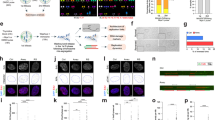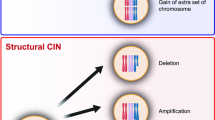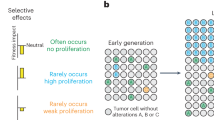Abstract
After DNA or spindle damage, p53-defective tumor cells undergo a complex cycle of reversible polyploidy. How this process occurs and more importantly, why, has recently become the focus of several research groups, prompting this review in which we discuss two related phenomena that accompany the reversible polyploidy of tumor cells: the induction of meiosis genes such as MOS and the decrease in genomic instability observed during the reversion from polyploidy to para-diploidy. The reversible polyploidy likely provides the means through which the balance between increased chromosome instability (CIN), driving genetic variation and decreased CIN, necessary for perpetuating these malignant clones, is maintained. These concepts are integrated with recent findings that many meiotic and self-renewal genes become activated during reversible polyploidy and lead us to the hypothesis that tumor cell immortality may be achieved through germline-like transmission.
This is a preview of subscription content, access via your institution
Access options
Subscribe to this journal
Receive 50 print issues and online access
$259.00 per year
only $5.18 per issue
Buy this article
- Purchase on Springer Link
- Instant access to full article PDF
Prices may be subject to local taxes which are calculated during checkout


Similar content being viewed by others
Abbreviations
- ETC:
-
endopolyploid tumor cells
References
Cahill DP, Kinzler KW, Vogelstein B, Lengauer C . (1999). Genetic instability and darwinian selection in tumors. Trends Cell Biol 9: M57–M60.
Castedo M, Coquelle A, Vivet S, Vitale I, Kauffmann A, Dessen P et al. (2006). Apoptosis regulation in tetraploid cancer cells. EMBO J 25: 2584–2595.
Castedo M, Perfettini JL, Roumier T, Andreau K, Medema R, Kroemer G . (2004). Cell death by mitotic catastrophe: a molecular definition. Oncogene 23: 2825–2837.
Chandhok NS, Pellman D . (2009). A little CIN may cost a lot: revisiting aneuploidy and cancer. Curr Opin Genet Dev 19: 74–81.
Choi T, Rulong S, Resau J, Fukasawa K, Matfen W, Kuriyama R et al. (1996). Mos/mitogen-activated protein kinase can induce early meiotic phenotypes in the absence of maturation-promoting factor: a novel system for analyzing spindle formation during meiosis I. Proc Natl Acad Sci USA 93: 4730–4735.
Chu K, Teele N, Dewey MW, Albright N, Dewey WC . (2004). Computerized video time lapse study of cell cycle delay and arrest, mitotic catastrophe, apoptosis and clonogenic survival in irradiated14-3-3s and CDKN1A (p21) knockout cell lines. Rad Res 162: 270–286.
Cleveland LR . (1947). The origin and evolution of meiosis. Science 105: 287.
de la Hoz C, Baroja A . (1993). Proliferative behaviour of high-ploidy cells in two murine tumor lines. J Cell Sci 104: 31–36.
Duesberg P, Li R, Fabarius A, Hehlmann R . (2006). Aneuploidy and cancer: from correlation to causation. Contrib Microbiol 13: 16–44.
Erenpreisa J, Cragg MS . (2007). Cancer: A matter of life-cycle. Cell Biol Int 31: 1507–1510.
Erenpreisa J, Cragg MS, Fringes B, Sharakhov I, Illidge TM . (2000). Release of mitotic descendants by giant cells from irradiated Burkitt's lymphoma cell line. Cell Biol Int 24: 635–648.
Erenpreisa J, Cragg MS, Salmina K, Hausmann M, Scherthan H . (2009). The role of meiotic cohesin REC8 in chromosome segregation in gamma irradiation-induced endopolyploid tumor cells. Exp Cell Res 315: 2593–2603.
Erenpreisa J, Ivanov A, Wheatley SP, Kosmacek EA, Ianzini F, Anisimov AP et al. (2008). Endopolyploidy in irradiated p53-defficient tumor cell lines: persistence of cell division activity in giant cells expressing Aurora-B kinase. Cell Biol Int 32: 1044–1056.
Erenpreisa J, Kalejs M, Cragg MS . (2005). Mitotic catastrophe and endomitosis in tumor cells: an evolutionary key to a molecular solution. Cell Biol Int 29: 1012–1018.
Erenpreisa J, Wheatley D . (2005). Endopolyploidy in development and cancer; survival of the fattest’? Cell Biol Int 29: 981–982.
Extavour C . (2009). Oogenesis: making the Mos of meiosis. Curr Biol 19: R489–R491.
Forer A . (2009). Ploidy and division in cancer and mosquito hind-gut cells. Cell Biol Int 33: 253.
Fukasawa K, Murakami MS, Blair DG, Kuriyama R, Hunt T, Fischinger P et al. (1994). Similarities between somatic cells overexpressing the mos oncogene and oocytes during meiotic interphase. Cell Growth Differ 5: 1093–1103.
Ganem NJ, Pellman D . (2007). Limiting the proliferation of polyploid cells. Cell 131: 437–440.
Gergely F, Basto R . (2008). Multiple centrosomes: together they stand, divided they fall. Genes Dev 22: 2291–2296.
Gisselsson D, Hakanson U, Stoller P, Marti D, Jin Y, Rosengren AH et al. (2008). When the genome plays dice: circumvention of the spindle assembly checkpoint and near-random chromosome Segregation in multipolar cancer cell mitoses. PLoS ONE 3: e1871.
Gorgoulis VG, Zacharatos P, Mariatos G, Liloglou T, Kokotas S, Kastrinakis N et al. (2001). Deregulated expression of c-mos in non-small cell lung carcinomas: relationship with p53 Status, genomic instability, and tumor kinetics. Cancer Res 61: 538–549.
Goshima G, Nedelec F, Vale RD . (2005). Mechanisms for focusing mitotic spindle poles by minus end-directed motor proteins. J Cell Biol 171: 229–240.
Hanahan D, Weinberg RA . (2000). The hallmarks of cancer. Cell 100: 57–70.
Haroske G, Baak JP, Danielsen H, Giroud F, Gschwendtner A, Oberholzer M et al. (2001). Fourth updated ESACP consensus report on diagnostic DNA image cytometry. Anal Cell Pathol 23: 89–95.
Höglund M, Gisselsson D, Säll T, Mitelman F . (2002). Coping with complexity. Multivariate analysis of tumor karyotypes. Cancer Genet Cytogenet 135: 103–109.
Hurst LD, Nurse P . (1991). A note on the evolution of meiosis. J Theor Biol 150: 561–563.
Ianzini F, Kosmacek EA, Nelson ES, Napoli E, Erenpreisa J, Kalejs M et al. (2009). Activation of meiosis-specific genes is associated with depolyploidization of human tumor cells following radiation-induced mitotic catastrophe. Cancer Res 69: 2296–2304.
Ianzini F, Mackey MA . (2002). Development of the large scale digital cell analysis system. Radiat Prot Dosimetry 99: 289–293.
Illidge TM, Cragg MS, Fringes B, Olive P, Erenpreisa J . (2000). Polyploid giant cells provide a survival mechanism for p53 mutant cells after DNA damage. Cell Biol Int 24: 621–633.
Ivanov A, Cragg MS, Erenpreisa J, Emzinsh D, Lukman H, Illidge TM . (2003). Endopolyploid cells produced after severe genotoxic damage have the potential to repair DNA double strand breaks. J Cell Sci 116: 4095–4106.
Kalejs M, Ivanov A, Plakhins G, Cragg MS, Emzins Dz, Illidge TM et al. (2006). Upregulation of meiosis-specific genes in lymphoma cell lines following genotoxic insult and the induction of mitotic catastrophe. BMC Cancer 6: 6.
Kondrashov AS . (1994). The asexual ploidy cycle and the origin of sex. Nature 370: 213–216.
Kondrashov AS . (1997). Evolutionary genetics of life-cycles. Annu Rev Ecol Syst 28: 391–435.
Kwon M, Godinho SA, Chandhok NS, Ganem NJ, Azioune A, Thery M et al. (2008). Mechanism to suppress multipolar divisions in cancer cells with extra centrosomes. Genes Dev 22: 2189–2203.
Lee HO, Davidson JM, Duronio RJ . (2009). Endoreplication: polyploidy with purpose. Genes Dev 23: 2461–2477.
Ling YH, Yang Y, Tornos C, Singh B, Perez-Soler R . (1998). Paclitaxel-induced apoptosis is associated with expression and activation of c-Mos gene product in human ovarian carcinoma SKOV3 cells. Cancer Res 58: 3633–3640.
Martin F, Puig PE, Ghiringhelli F, Chauffert B . (2009). DNA-damaged polyploid cancer cells can reverse to diploidy: an ordered, but little understood, process of genomic reduction [with reference to the previous comments of Forer (2008) and Wheatley (2008a and b)]. Cell Biol Int 33: 702–703.
Nagl W . (1978). Endopolyploidy and Polyteny in Differentiation and Evolution. North-Holland Pubublishing: Amsterdam; New York; Oxford.
Nasmyth K . (2001). Disseminating the genome: joining, resolving, and separating sister chromatids during mitosis and meiosis. Ann Rev Genet 35: 673–745.
Nebreda AR, Ferby I . (2000). Regulation of the meiotic cell cycle in oocytes. Curr Opin Cell Biol 12: 666–675.
Page AW, Orr-Weaver TL . (1997). Stopping and starting the meiosis cycle. Curr Opin Genet Dev 7: 23–31.
Petronczki M, Siomos MF, Nasmyth K . (2003). Un menage a quatre: the molecular biology of chromosome segregation in meiosis. Cell 112: 423–440.
Prieur-Carrillo G, Chu K, Lindqvist J, Dewey WC . (2003). Computerized video time-lapse (CVTL) analysis of the fate of giant cells produced by X-irradiating EJ30 human bladder carcinoma cells. Radiat Res 159: 705–712.
Puig PE, Guill MN, Bouchot A, Droin N, Cathelin D, Bouyer F et al. (2008). Tumor cells can escape DNA-damaging cisplatin through DNA endoreduplication and reversible polyploidy. Cell Biol Int 32: 1031–1043.
Quintyne NJ, Reing JE, Hoffelder DR, Gollin SM, Saunders WS . (2005). Spindle multipolarity is prevented by centrosomal clustering. Science 307: 127–129.
Raff MC . (1992). Social controls on cell survival and cell death. Nature 356: 397–400.
Raikov IB . (1982). The Protozoan Nucleus, Morphology and Evolution. Springer Verlag: Wien-New York.
Rajaraman R, Guernsey DL, Rajaraman MM, Rajaraman SR . (2006). Stem cells, senescence, neosis and self-renewal in cancer. Cancer Cell Int 6: 25.
Rajaraman R, Guernsey DL, Rajaraman MM, Rajaraman SR . (2007). Neosis - a parasexual somatic reduction division in cancer. Int J Hum Genet 7: 29–48.
Salmina K, Jankevics E, Huna A, Perminov D, Radovica I, Klymenko T et al. (2010). Up-regulation of the embryonic self-renewal network through reversible polyploidy in irradiated p53-mutant tumor cells. Exp Cell Res 316: 2099–2112.
Stewenius Y, Gorunova L, Jonson T, Larsson N, Hoglund M, Mandahl N et al. (2005). Structural and numerical chromosome changes in colon cancer develop through telomere-mediated anaphase bridges, not through mitotic multipolarity. Proc Natl Acad Sci USA 102: 5541–5546.
Storchová Z, Breneman A, Cande J, Dunn J, Burbank K, O′Toole E et al. (2006). Genome-wide genetic analysis of polyploidy in yeast. Nature 443: 541–547.
Storchova Z, Pellman D . (2004). From polyploidy to aneuploidy, genome instability and cancer. Nat Rev Mol Cell Biol 5: 45–54.
Sundaram M, Guernsey DL, Rajaraman MM, Rajaraman R . (2004). Neosis: a novel type of cell division in cancer. Cancer Biol Ther 3: 207–218.
Therman E, Kuhn EM . (1989). Mitotic modifications and aberrations in cancer. Crit Rev Cancer 1: 293–305.
Thompson SL, Compton DA . (2010). Proliferation of aneuploid human cells is limited by a p53-dependent mechanism. J Cell Biol 188: 369–381.
Vakifahmetoglu H, Olsson M, Zhivotovsky B . (2008). Death through a tragedy: mitotic catastrophe. Cell Death Differ 15: 1153–1162.
Verlhac MH, Kubiak JZ, Weber M, Géraud G, Colledge WH, Evans MJ et al. (1996). Mos is required for MAP kinase activation and is involved in microtubule organization during meiotic maturation in the mouse. Development 122: 815–822.
Vitale I, Senovilla L, Jemaà M, Michaud M, Galluzzi L, Kepp O et al. (2010). Multipolar mitosis of tetraploid cells: inhibition by p53 and dependency on Mos. EMBO J 7: 1272–1284.
Weaver BA, Cleveland DW . (2007). Aneuploidy: instigator and inhibitor of tumorigenesis. Cancer Res 67: 10103–10105.
Wheatley D . (2008). Growing evidence of the repopulation of regressed tumors by the division of giant cells. Cell Biol Int 32: 1029–1030.
Wilkins AS, Holliday R . (2009). The evolution of meiosis from mitosis. Genetics 181: 3–12.
Wu JQ, Kornbluth S . (2008). Across the meiotic divide – CSF activity in the post-Emi2/XErp1 era. J Cell Sci 121: 3509–3514.
Yew N, Strobel M, Vande Woude GF . (1993). Mos and the cell cycle: the molecular basis of the transformed phenotype. Curr Opin Genet Dev 3: 19–25.
Zhou RP, Oskarsson M, Paules RS, Schulz N, Cleveland D, Vande Woude GF . (1991). Ability of the c-mos product to associate with and phosphorylate tubulin. Science 251: 671–675.
Acknowledgements
We thank many collaborators and colleagues for helpful discussions, in particular Kirsten Walen, Helmut Zacharias, Evgenia Zybina and Dmitry Perminov and apologize to those authors not cited here due to space restrictions.
Author information
Authors and Affiliations
Corresponding authors
Ethics declarations
Competing interests
The authors declare no conflict of interest.
Rights and permissions
About this article
Cite this article
Erenpreisa, J., Cragg, M. MOS, aneuploidy and the ploidy cycle of cancer cells. Oncogene 29, 5447–5451 (2010). https://doi.org/10.1038/onc.2010.310
Received:
Revised:
Accepted:
Published:
Issue Date:
DOI: https://doi.org/10.1038/onc.2010.310
Keywords
This article is cited by
-
Understanding aneuploidy in cancer through the lens of system inheritance, fuzzy inheritance and emergence of new genome systems
Molecular Cytogenetics (2018)
-
Cancer drug target identification and node-level analysis of the network of MAPK pathways
Network Modeling Analysis in Health Informatics and Bioinformatics (2018)
-
Why it is crucial to analyze non clonal chromosome aberrations or NCCAs?
Molecular Cytogenetics (2016)
-
Linking genomic reorganization to tumor initiation via the giant cell cycle
Oncogenesis (2016)
-
DNA damage-induced metaphase I arrest is mediated by the spindle assembly checkpoint and maternal age
Nature Communications (2015)



